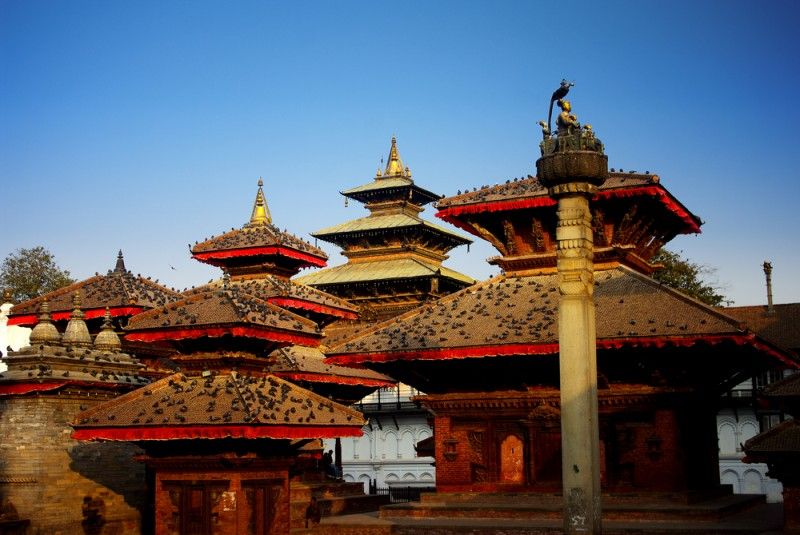The Cultural Heartbeat: Kathmandu Valley
The Kathmandu Valley is the cultural heartbeat of Nepal, home to an extraordinary collection of UNESCO World Heritage Sites that blend history, spirituality, and artistry. From grand royal palaces to sacred stupas and intricately carved temples, this valley showcases the essence of Nepal’s heritage. Exploring these timeless sites offers travelers a chance to walk through centuries of history while experiencing authentic culture, vibrant festivals, and living traditions. Nestled in the foothills of the Himalayas, the Kathmandu Valley is not just a destination – it is a living museum where every corner tells a story of kings, artisans, and spiritual seekers.
Highlights / Key Features
Experience the cultural soul of the Kathmandu Valley through these essential moments.
★ Cultural Immersion
Visit seven UNESCO-listed monuments within the Kathmandu Valley.
⛪ Royal Heritage
Explore Durbar Squares of Kathmandu, Patan, and Bhaktapur.
✎ Spiritual Power
Witness the spiritual power of Pashupatinath Temple.
✶ Himalayan Serenity
Experience serenity at Boudhanath and Swayambhunath stupas.
🍛 Authentic Local Life
Discover authentic Newar culture and traditional food.
🎉 Vibrant Traditions
Immerse in the valley’s festivals, art, and local experiences.
Kathmandu Durbar Square – Heart of Royal Heritage
Kathmandu Durbar Square, once the royal palace complex of the Malla kings, is the historic soul of the city. A masterpiece of wood, stone, and metal craftsmanship, the square is lined with courtyards, temples, and statues that narrate Nepal’s rich heritage. The Living Goddess Kumari resides here, adding an authentic spiritual dimension to this tourism hub. For travelers, strolling through the square is like stepping back in time, where every intricately carved window and monument reflects the valley’s artistic genius.

Patan & Bhaktapur – Living Cities of Art
Patan Durbar Square is celebrated for its breathtaking temples and Newar artistry. Its golden temple, Krishna Mandir, and courtyards reflect the valley’s devotion to both Hindu and Buddhist traditions. Just a short drive away, Bhaktapur Durbar Square enchants visitors with medieval charm – brick-paved streets, pottery squares, and the iconic 55-window palace. Both cities preserve authentic culture, offering local experiences where travelers can taste traditional food, watch artisans at work, and witness rituals that keep Nepal’s living heritage alive.
Sacred Stupas – Spiritual Icons of Nepal
The Kathmandu Valley is home to two of the world’s most significant Buddhist stupas: Boudhanath and Swayambhunath. Boudhanath, with its massive white dome and watchful Buddha eyes, is a pilgrimage center where monks chant mantras and prayer flags flutter in the wind. Swayambhunath, known as the Monkey Temple, sits atop a hill offering panoramic views of the Himalayas and the valley. Both sites are not only sacred but also essential stops for travelers seeking spiritual adventure, peace, and a glimpse of Nepal’s authentic culture.
Pashupatinath Temple – Sacred Hindu Pilgrimage
One of the most revered Hindu temples in the world, Pashupatinath stands on the banks of the holy Bagmati River. Dedicated to Lord Shiva, it draws thousands of devotees daily and becomes especially vibrant during Maha Shivaratri festival. The temple complex is a blend of architecture, rituals, and spirituality – a symbol of Nepal’s living heritage. For travelers, it offers a rare opportunity to witness authentic Hindu traditions, making it a vital part of cultural tourism in the Kathmandu Valley.
Treasures of the Kathmandu Valley
Your essential guide to the UNESCO World Heritage Sites and cultural significance of Nepal's historic heart.
1. How many UNESCO World Heritage Sites are in Kathmandu Valley?
The Kathmandu Valley has seven UNESCO sites, including Durbar Squares of Kathmandu, Patan, and Bhaktapur, plus Pashupatinath, Boudhanath, Swayambhunath, and Changu Narayan.
2. Why is Kathmandu Valley significant for heritage tourism?
It preserves centuries of culture, art, and religion in one compact area, offering travelers an authentic view of Nepal’s living history.
3. When is the best time to visit Kathmandu Valley’s UNESCO sites?
Autumn (September–November) and spring (March–May) are ideal for pleasant weather and opportunities to witness festivals and rituals.
4. Can I experience local culture while visiting UNESCO sites?
Yes! Many sites are surrounded by traditional neighborhoods where you can enjoy homestays, try authentic food, and engage in local experiences.
5. Are guided tours available for UNESCO sites?
Absolutely. Guided tours help travelers understand the stories, history, and symbolism behind each monument, enhancing cultural travel experiences.
Discover the Crown Jewel of Heritage Tourism
The UNESCO World Heritage Sites of the Kathmandu Valley are not just monuments; they are vibrant centers of living culture, art, and spirituality. From the royal palaces of Patan and Bhaktapur to the sacred stupas and revered Pashupatinath Temple, these landmarks connect you to the timeless essence of Nepal. Whether you seek history, spiritual adventure, or authentic local experiences, the Kathmandu Valley offers it all. Start your journey with Namo Nepal and discover why this valley is the crown jewel of heritage tourism in the Himalayas.
Start Your Namo Nepal Journey